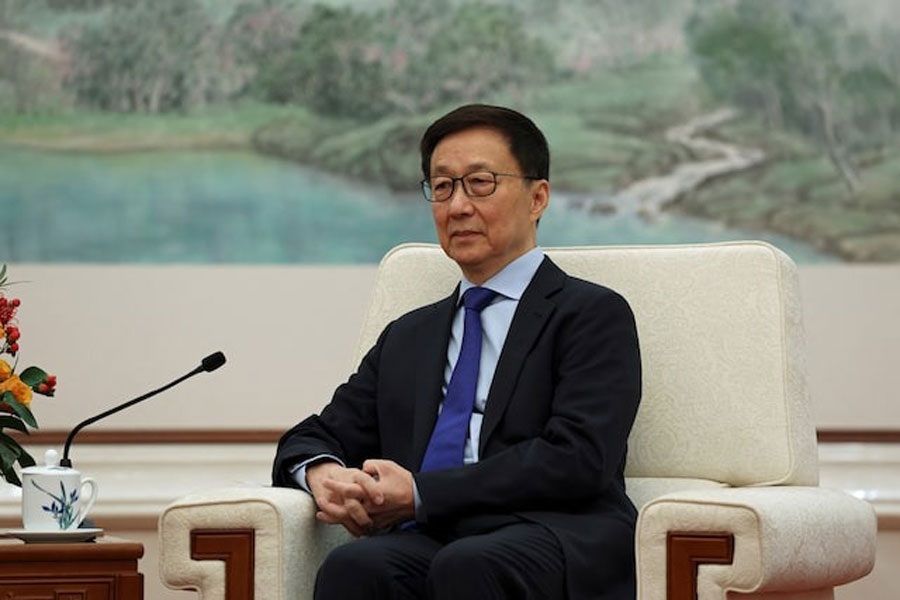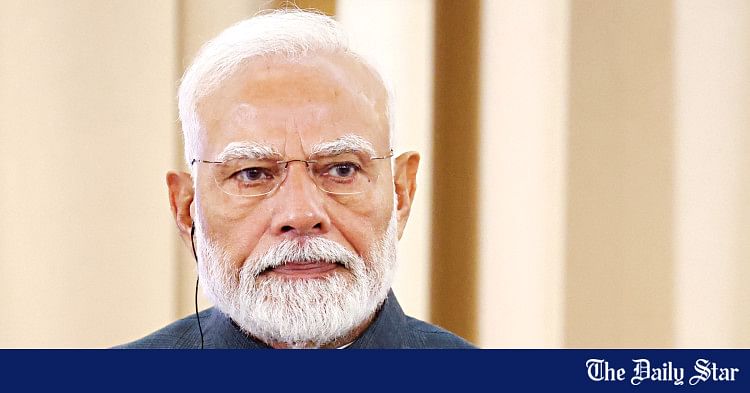I'll tell you a joke. A Dalit believes that he lives in a democratic country....In democracy, we do not assassinate people with different views. That work is given to dictator Xi.
You are using an out of date browser. It may not display this or other websites correctly.
You should upgrade or use an alternative browser.
You should upgrade or use an alternative browser.
[🇮🇳] India VS China
Loading...
Press space to scroll through posts
Krishna with Flute
Senior Member
- Joined
- Jan 26, 2024
- Messages
- 4,935
- Likes
- 2,617
- Axis Group

I'll tell you a joke. A Dalit believes that he lives in a democratic country....
I'll tell you a joke. A Dalit believes that he lives in a democratic country....
In a survey, 70% Chinese believed that China is a democracy.
Has anyone asked Dalit?In a survey, 70% Chinese believed that China is a democracy.



Saif
Senior Member
- Joined
- Jan 24, 2024
- Messages
- 16,044
- Likes
- 8,050
- Nation

- Axis Group


India seeks permanent solution to border dispute with China
Indian Defence Minister Rajnath Singh told his Chinese counterpart that the two countries should seek a "permanent solution" to their decades-old border dispute, in a new push for a conclusive outcome. Singh met China's Dong Jun on the sidelines of the meeting of the defence ministers of the Shang
India seeks permanent solution to border dispute with China
REUTERS
Published :
Jun 28, 2025 17:37
Updated :
Jun 28, 2025 17:37

India's Defence Minister Rajnath Singh attends the Shanghai Cooperation Organisation (SCO) Defence Ministers' Meeting in Qingdao, Shandong province, China June 26, 2025. Photo : REUTERS/Florence Lo
Indian Defence Minister Rajnath Singh told his Chinese counterpart that the two countries should seek a "permanent solution" to their decades-old border dispute, in a new push for a conclusive outcome.
Singh met China's Dong Jun on the sidelines of the meeting of the defence ministers of the Shanghai Cooperation Organisation (SCO) in Qingdao on Thursday and stressed on solving issues between the countries through a structured roadmap, India's defence ministry said in a statement on Friday,
"Singh also stressed on border management and to have a permanent solution of border demarcation by rejuvenating the established mechanism on the issue," the statement said, referring to the border talks process between the Asian giants.
New Delhi's stress on a permanent solution is considered significant as India has in the past generally used phrases such as seeking an early resolution to the dispute.
Beijing says the border dispute should not affect the larger relationship and differences should be managed properly until a mutually acceptable solution is found through dialogue.
There was no Chinese defence ministry statement yet on the meeting and its foreign ministry did not immediately respond to a request for comment on India's statement.
The world's two most populous nations - both nuclear powers - share a 3,800 km (2,400 mile), largely undemarcated and disputed border in the Himalayas and have gone to war over it.
Although the frontier has been mostly peaceful in recent decades, a deadly clash between their troops in 2020 resulted in the deaths of 20 Indian and four Chinese soldiers.
The clash led to a four-year military standoff with both armies deploying tens of thousands of troops in the mountains until they reached a pact in October to step back, leading to a thaw in ties.
During his meeting with Dong, Singh also called for bridging the trust deficit created after the 2020 standoff, New Delhi said.
The defence ministers agreed to continue consultations to achieve progress on "disengagement, de-escalation, border management and eventual de-limitation", the statement added.
Beijing and New Delhi have continued to mend ties and said this month that they have agreed to expedite the resumption of direct air services, which were suspended after the 2020 clash, and step up communication.
SCO is a 10-nation Eurasian security and political grouping whose members include China, Russia, India, Pakistan, and Iran. Their defence ministers' meeting was held as a precursor to the annual summit of its leaders set for the autumn.
The SCO defence ministers were unable to adopt a joint statement at the end of their meeting due to a lack of consensus on referring to "terrorism", India said on Thursday.
REUTERS
Published :
Jun 28, 2025 17:37
Updated :
Jun 28, 2025 17:37
India's Defence Minister Rajnath Singh attends the Shanghai Cooperation Organisation (SCO) Defence Ministers' Meeting in Qingdao, Shandong province, China June 26, 2025. Photo : REUTERS/Florence Lo
Indian Defence Minister Rajnath Singh told his Chinese counterpart that the two countries should seek a "permanent solution" to their decades-old border dispute, in a new push for a conclusive outcome.
Singh met China's Dong Jun on the sidelines of the meeting of the defence ministers of the Shanghai Cooperation Organisation (SCO) in Qingdao on Thursday and stressed on solving issues between the countries through a structured roadmap, India's defence ministry said in a statement on Friday,
"Singh also stressed on border management and to have a permanent solution of border demarcation by rejuvenating the established mechanism on the issue," the statement said, referring to the border talks process between the Asian giants.
New Delhi's stress on a permanent solution is considered significant as India has in the past generally used phrases such as seeking an early resolution to the dispute.
Beijing says the border dispute should not affect the larger relationship and differences should be managed properly until a mutually acceptable solution is found through dialogue.
There was no Chinese defence ministry statement yet on the meeting and its foreign ministry did not immediately respond to a request for comment on India's statement.
The world's two most populous nations - both nuclear powers - share a 3,800 km (2,400 mile), largely undemarcated and disputed border in the Himalayas and have gone to war over it.
Although the frontier has been mostly peaceful in recent decades, a deadly clash between their troops in 2020 resulted in the deaths of 20 Indian and four Chinese soldiers.
The clash led to a four-year military standoff with both armies deploying tens of thousands of troops in the mountains until they reached a pact in October to step back, leading to a thaw in ties.
During his meeting with Dong, Singh also called for bridging the trust deficit created after the 2020 standoff, New Delhi said.
The defence ministers agreed to continue consultations to achieve progress on "disengagement, de-escalation, border management and eventual de-limitation", the statement added.
Beijing and New Delhi have continued to mend ties and said this month that they have agreed to expedite the resumption of direct air services, which were suspended after the 2020 clash, and step up communication.
SCO is a 10-nation Eurasian security and political grouping whose members include China, Russia, India, Pakistan, and Iran. Their defence ministers' meeting was held as a precursor to the annual summit of its leaders set for the autumn.
The SCO defence ministers were unable to adopt a joint statement at the end of their meeting due to a lack of consensus on referring to "terrorism", India said on Thursday.
Saif
Senior Member
- Joined
- Jan 24, 2024
- Messages
- 16,044
- Likes
- 8,050
- Nation

- Axis Group


Avoiding trade curbs vital for normalisation of ties, India tells China
India and China must resolve friction along their border, pull back troops and avoid "restrictive trade measures" to normalise their relationship, India's foreign minister told his Chinese counterpart in Beijing on Monday. India's Subrahmanyam Jaishankar met Wang Yi in Beijing during his first tri
Avoiding trade curbs vital for normalisation of ties, India tells China
REUTERS
Published :
Jul 14, 2025 19:56
Updated :
Jul 14, 2025 19:56

Chinese Vice President Han Zheng attends a meeting with Britain's Chancellor of the Exchequer Rachel Reeves (not pictured) at the Great Hall of the People in Beijing, China January 11, 2025. Photo : REUTERS/Florence Lo/Pool/Files
India and China must resolve friction along their border, pull back troops and avoid "restrictive trade measures" to normalise their relationship, India's foreign minister told his Chinese counterpart in Beijing on Monday.
India's Subrahmanyam Jaishankar met Wang Yi in Beijing during his first trip to the country since 2020, when a deadly border clash between their troops led to a four-year military standoff and damaged ties until a thaw began in October, when they agreed to step back.
"Good progress" made by the countries in the past nine months for normalisation of relations is a result of the resolution of friction along their border, Jaishankar told Wang.
India and China share a 3,800 km (2,400 miles) border that is poorly demarcated and has been disputed since the 1950s. They fought a brief but brutal border war in 1962 and talks over the decades to settle the border dispute have made slow progress.
Last month, Indian Defence Minister Rajnath Singh told his Chinese counterpart that the two countries should seek a "permanent solution" to the border dispute, seen as a new push by New Delhi for a conclusive outcome.
"It is now incumbent on us to address other aspects related to the border, including de-escalation," Jaishankar said, adding that it was also critical that restrictive trade measures and roadblocks be avoided to foster mutually beneficial cooperation.
The minister was speaking in the backdrop of Beijing's restrictions in recent months on supplies of critical minerals such as rare earth magnets and machinery for manufacturing of high-tech goods.
India holds the world's fifth-largest rare earth reserves but its domestic output remains underdeveloped.
There was no immediate Chinese readout of the talks between Jaishankar and Wang.
Jaishankar, who is in China to attend the meeting of foreign ministers of the Shanghai Cooperation Organisation, met Chinese Vice President Han Zheng earlier in the day, the official Chinese news agency Xinhua reported.
India and China should steadily advance practical cooperation and respect each other's concerns, Han told Jaishankar, Xinhua said.
REUTERS
Published :
Jul 14, 2025 19:56
Updated :
Jul 14, 2025 19:56
Chinese Vice President Han Zheng attends a meeting with Britain's Chancellor of the Exchequer Rachel Reeves (not pictured) at the Great Hall of the People in Beijing, China January 11, 2025. Photo : REUTERS/Florence Lo/Pool/Files
India and China must resolve friction along their border, pull back troops and avoid "restrictive trade measures" to normalise their relationship, India's foreign minister told his Chinese counterpart in Beijing on Monday.
India's Subrahmanyam Jaishankar met Wang Yi in Beijing during his first trip to the country since 2020, when a deadly border clash between their troops led to a four-year military standoff and damaged ties until a thaw began in October, when they agreed to step back.
"Good progress" made by the countries in the past nine months for normalisation of relations is a result of the resolution of friction along their border, Jaishankar told Wang.
India and China share a 3,800 km (2,400 miles) border that is poorly demarcated and has been disputed since the 1950s. They fought a brief but brutal border war in 1962 and talks over the decades to settle the border dispute have made slow progress.
Last month, Indian Defence Minister Rajnath Singh told his Chinese counterpart that the two countries should seek a "permanent solution" to the border dispute, seen as a new push by New Delhi for a conclusive outcome.
"It is now incumbent on us to address other aspects related to the border, including de-escalation," Jaishankar said, adding that it was also critical that restrictive trade measures and roadblocks be avoided to foster mutually beneficial cooperation.
The minister was speaking in the backdrop of Beijing's restrictions in recent months on supplies of critical minerals such as rare earth magnets and machinery for manufacturing of high-tech goods.
India holds the world's fifth-largest rare earth reserves but its domestic output remains underdeveloped.
There was no immediate Chinese readout of the talks between Jaishankar and Wang.
Jaishankar, who is in China to attend the meeting of foreign ministers of the Shanghai Cooperation Organisation, met Chinese Vice President Han Zheng earlier in the day, the official Chinese news agency Xinhua reported.
India and China should steadily advance practical cooperation and respect each other's concerns, Han told Jaishankar, Xinhua said.
Saif
Senior Member
- Joined
- Jan 24, 2024
- Messages
- 16,044
- Likes
- 8,050
- Nation

- Axis Group


Modi to visit China for first time in 7 years
Indian Prime Minister Narendra Modi will visit China for the first time in over seven years, a government source said yesterday, in a further sign of a diplomatic thaw with Beijing as tensions with the United States rise.
Modi to visit China for first time in 7 years
India’s security chief visits Moscow

Reuters file photo
Indian Prime Minister Narendra Modi will visit China for the first time in over seven years, a government source said yesterday, in a further sign of a diplomatic thaw with Beijing as tensions with the United States rise.
Modi will go to China for a summit of the multilateral Shanghai Cooperation Organisation that begins on August 31, the government source, with direct knowledge of the matter, told Reuters. India's foreign ministry did not immediately respond to a request for comment.
His trip will come at a time when India's relationship with the US faces its most serious crisis in years after President Donald Trump imposed the highest tariffs among Asian peers on goods imported from India, and has threatened an unspecified further penalty for New Delhi's purchases of Russian oil.
Modi's visit to the Chinese city of Tianjin for the summit of SCO will be his first since June 2018. Subsequently, Sino-Indian ties deteriorated sharply after a military clash along their disputed Himalayan border in 2020.
Meanwhile, India's National Security Adviser Ajit Doval is in Russia on a scheduled visit and is expected to discuss India's purchases of Russian oil in the wake of Trump's pressure on India to stop buying Russian crude, according to another government source.
India’s security chief visits Moscow
Reuters file photo
Indian Prime Minister Narendra Modi will visit China for the first time in over seven years, a government source said yesterday, in a further sign of a diplomatic thaw with Beijing as tensions with the United States rise.
Modi will go to China for a summit of the multilateral Shanghai Cooperation Organisation that begins on August 31, the government source, with direct knowledge of the matter, told Reuters. India's foreign ministry did not immediately respond to a request for comment.
His trip will come at a time when India's relationship with the US faces its most serious crisis in years after President Donald Trump imposed the highest tariffs among Asian peers on goods imported from India, and has threatened an unspecified further penalty for New Delhi's purchases of Russian oil.
Modi's visit to the Chinese city of Tianjin for the summit of SCO will be his first since June 2018. Subsequently, Sino-Indian ties deteriorated sharply after a military clash along their disputed Himalayan border in 2020.
Meanwhile, India's National Security Adviser Ajit Doval is in Russia on a scheduled visit and is expected to discuss India's purchases of Russian oil in the wake of Trump's pressure on India to stop buying Russian crude, according to another government source.
Latest Posts
-
-
-
-
[🇮🇳] India's giant space leap: After NISAR mission, Isro to launch 6,500-kg US satellite
- Latest: Krishna with Flute
-
-
-
Latest Posts
-
-
-
-
[🇮🇳] India's giant space leap: After NISAR mission, Isro to launch 6,500-kg US satellite
- Latest: Krishna with Flute
-
-
-
-



































